Two new commercial landers are set to head to the Moon next year.
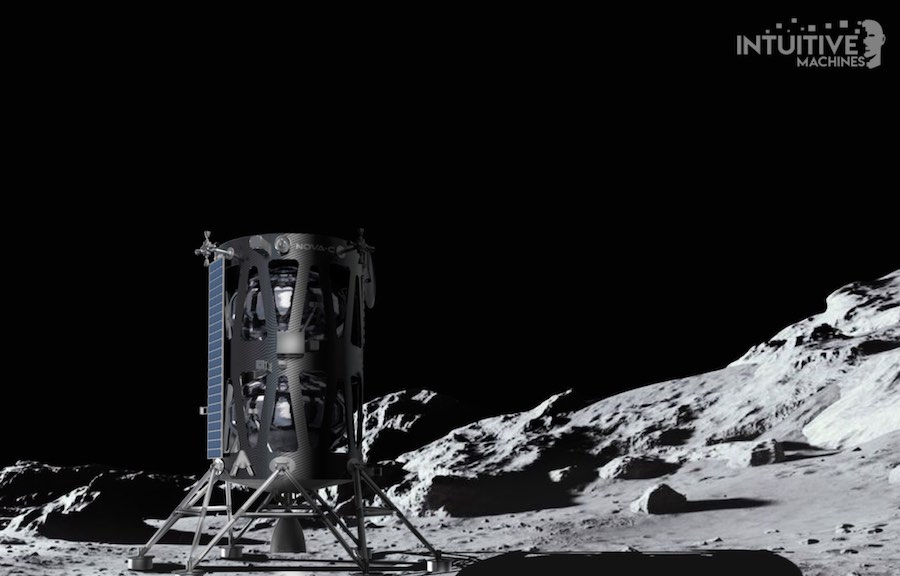
Intuitive Machines
NASA is about to head back to the Moon, in a big way. After a long hiatus, two new lunar missions are set to head back to the lunar surface as precursors to the crewed Artemis missions. These will represent the first new lunar missions for NASA since the Lunar Atmosphere and Dust Environment Explorer (LADEE) orbiter in 2013, and the first lunar landings for the space agency since the Apollo era. NASA's Lunar Reconnaissance Orbiter launched in 2009 also remains operational in orbit around the Moon.
The lunar missions are proof-of-concept landers that will soon carry small payloads and experiments to the lunar surface. NASA awarded contracts to two companies, Astrobotic and Intuitive Machines, in May 2019 to carry out the landings under NASA’s Commercial Lunar Payload Services (CLPS) program.
"We've finished the work of assigning science and technology payloads to each of the initial CLPS deliveries," says Chris Culbert (NASA-JSC) in a January 2020 press release. "This step allows our commercial partners to complete the important technical integration work necessary to fly the payloads and brings us a step closer to launching and landing the investigations that will help us better understand the Moon ahead of sending the first woman and next man to the Moon."
Peregrine Mission One
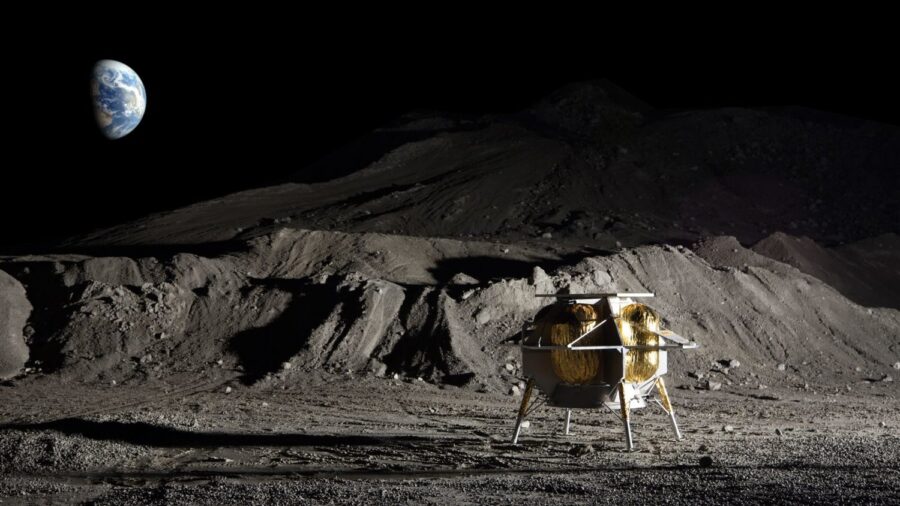
Astrobotic
First is Astrobotic is based out of Pittsburgh, Pennsylvania. Astrobotic will launch its Peregrine lunar lander in July 2021 as part of the United Launch Alliance’s inaugural launch of a Vulcan-Centaur rocket. Astrobotic's Peregrine lander will carry 11 NASA payloads to Lacus Mortis, including the following:
- Fluxgate Magnetometer (MAG): Designed by NASA Goddard to characterize localized magnetic fields near the lunar surface.
- Neutron Measurements at the Lunar Surface (NMLS): Developed at the Marshall Space Flight Center, NMLS will use a neutron spectrometer to detect the presence of water and other rare elements on the lunar surface.
- Neutron Spectrometer System (NSS): Developed by NASA AMES, NSS will also use a spectrometer to search for hydrogen-bearing material in the lunar regolith in the hunt for water near the landing site.
- Prospect Ion-Trap Mass Spectrometer (PITMS) for Lunar Surface Volatiles: A proven instrument that already flew once with the European Space Agency's Rosetta mission, a modified PITMS will look to characterize volatiles in the tenuous lunar exosphere during descent and landing.
- Mass Spectrometer Observing Lunar Operations (MSolo): Under development at the Kennedy Space Center, MSolo will look at low-molecular weight volatiles, including spacecraft outgassing and interaction with the local lunar surface and exosphere.
- Near-Infrared Volatile Spectrometer System (NIRVSS): Developed by the Ames Research Center, NIRVSS will map the surface temperature near the landing site and measure the amounts subsurface methane, carbon dioxide, and hydration present for possible future use by lunar astronauts.
- Linear Energy Transfer Spectrometer (LETS): Based on flight-proven hardware aboard NASA’s uncrewed 2014 Orion flight, LETS will measure radiation levels present at the lunar surface. The Johnson Spaceflight Center is responsible for its development.
- Photovoltaic Investigation on Lunar Surface (PILS): Designed at the Glenn Research Center, PILS will demonstrate the feasibility of using advanced solar arrays for power on future crewed missions to the lunar surface.
- Surface Exosphere Alterations by Landers (SEAL): Designed by NASA Goddard, SEAL will look at how the landing disturbs and contaminates samples at the local site.
"Astrobotic's Peregrine Mission One program has successfully passed structural qualification testing," says Alivia Chapla (Astrobotics). "Testing was conducted over two months at the Dayton T. Brown Inc. commercial test facility in Bohemia, New York."
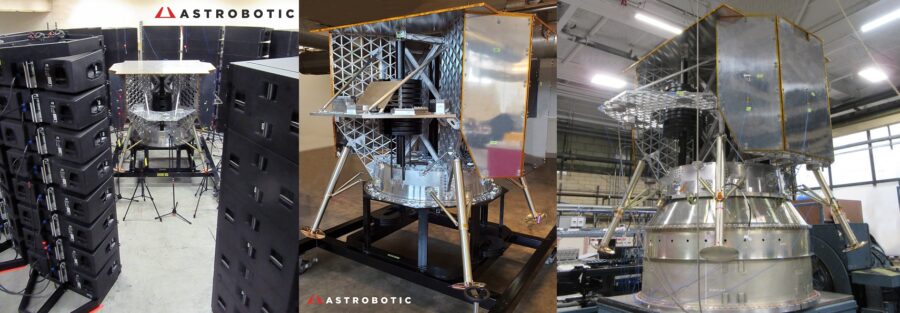
Astrobotic
Astrobotic's Peregrine Mission One will operate for about eight days on the lunar surface. The mission will also partner with The Arch Foundation to carry a copy of Wikipedia micro-etched on nickel wafers, as part of Long Now Foundation’s Rosetta Project. A similar disk crashed on the lunar surface with Israel’s Beresheet lander on April 11, 2019.
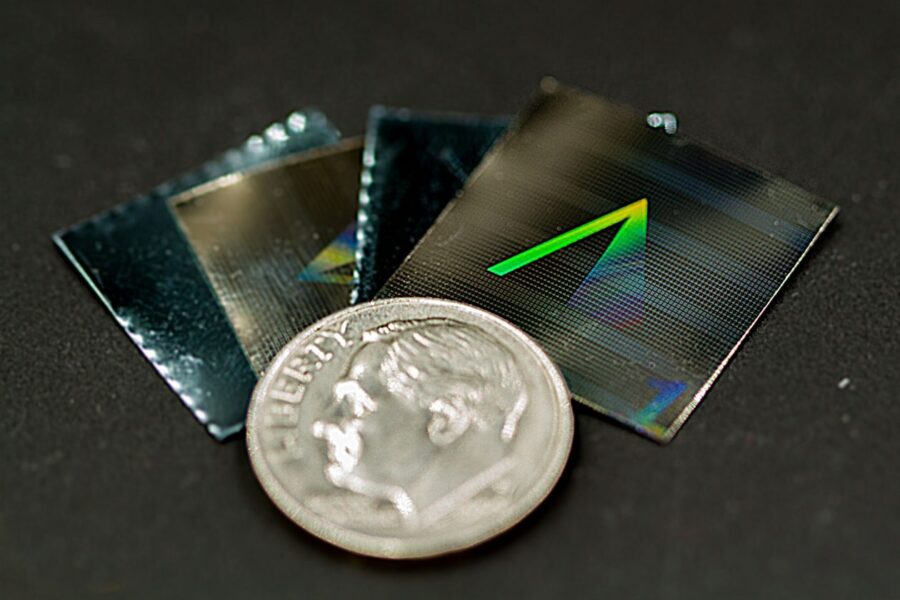
Arch Mission Foundation
Mission Two
Next up is Intuitive Machines based out of Houston, Texas. On October 11, 2021, their NOVA-C lander will launch on a SpaceX Falcon 9 Block 5 rocket for a landing at Oceanus Procellarum, near where Apollo 18 would have landed, had the U.S. continued the Apollo Moon program.
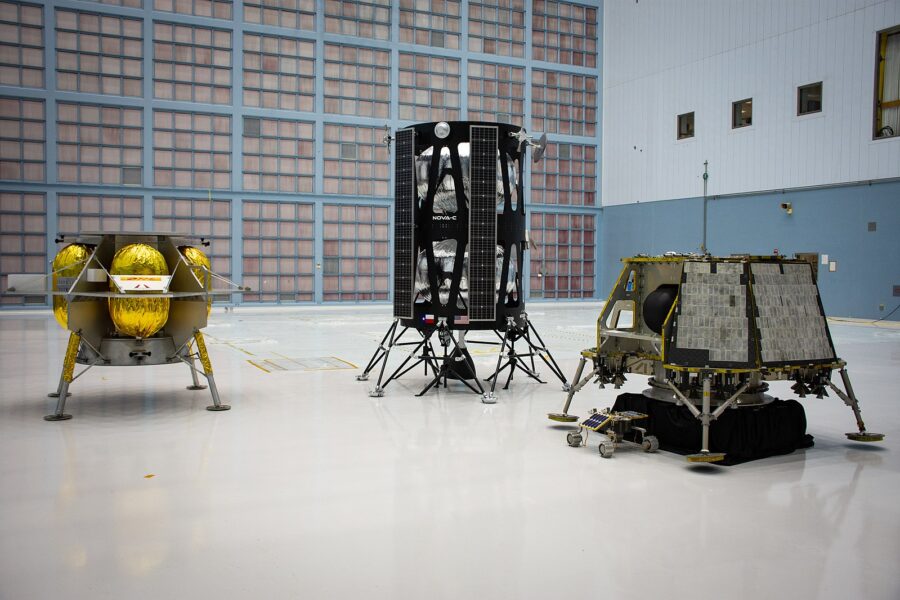
NASA / Goddard / Rebecca Roth
Intuitive Machines’ first Moon landing will carry five payloads to the lunar surface, including:
- Low–Frequency Radio Observations for Near Side Lunar Surface (ROLSES): Designed at NASA Goddard, ROLSES will serve as a pathfinder for a possible future radio observatory on the Moon, investigating the lunar radio environment. ROLSES will observe solar radio bursts and measure the scale height and density of the photo-electron sheath environment present near the lunar surface.
- Stereo Cameras for Lunar Plume–Surface Studies (SCALPSS): Developed at NASA Langley, SCALPSS will capture the landing plume stirred up by the lander on descent, in an effort to design future engines producing less site contamination.
- Lunar Node 1 Navigation Demonstrator (LN-1): Designed at Marshall Spaceflight Center, LN-1 will demonstrate autonomous navigation capabilities.
Lunar Missions
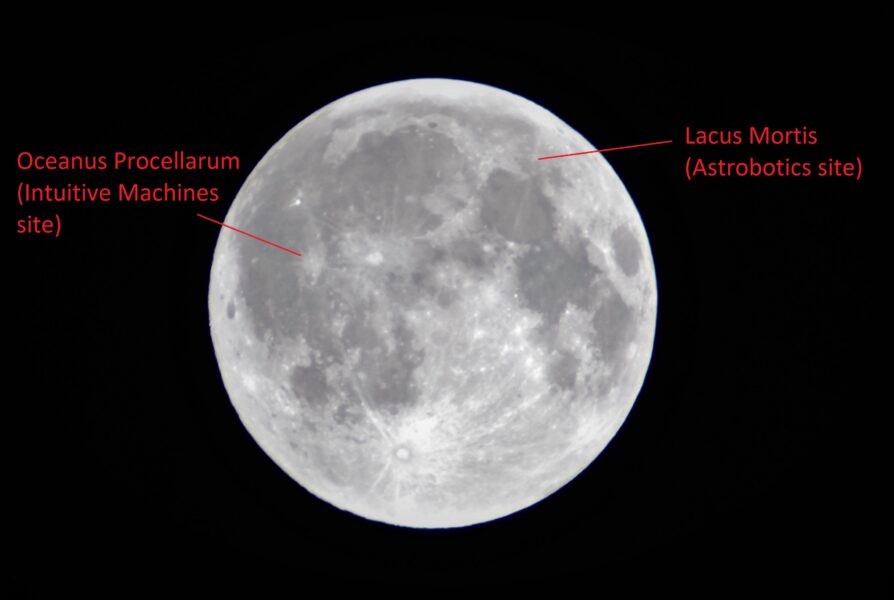
Dave Dickinson
Both lunar landers will also carry duplicates of the following two payloads:
- Navigation Doppler Lidar for Precise Velocity and Range Sensing (NDL): Developed by the Langley Research Center, NDL will use Light Detection and Ranging (LIDAR) for a pinpoint landing on the Moon.
- Laser Retro-reflector Array (LRA): Like early NASA and Soviet missions, both the Peregrine and NOVA-C lander will each carry a cluster of eight 1.25-centimeter (half-inch) laser retroreflectors to accurately determine the landers’ positions on the lunar surface. These new retroreflectors were designed by Goddard Space Flight Center.
There's more in store. These missions are part of NASA’s larger Artemis initiative, which will include the Capstone pathfinder mission in preparation for the crewed Lunar Gateway orbiting the Moon, and a return of astronauts to the lunar surface scheduled for the end of 2024.
In the meantime, the first uncrewed launch of the Space Launch System (SLS) rocket with 13 smallsat payloads is set for November 2021, with the first crewed Orion/Artemis 2 lunar flyby mission set for 2023. The first Lunar Gateway module is also due to launch in 2023, as is the first flight of Astrobotic’s larger Griffin lander, which would deliver the VIPER rover to the lunar south pole to prospect for water ice.
There's a lot in store for NASA and the U.S. as we aim for the Moon in the coming years.
 1
1









Comments
Judit
November 30, 2021 at 2:51 am
Hi, can I join to this your mission somehow as an artist from Europe too?
With colorful greetings from Switzerland,
Judit
You must be logged in to post a comment.
You must be logged in to post a comment.